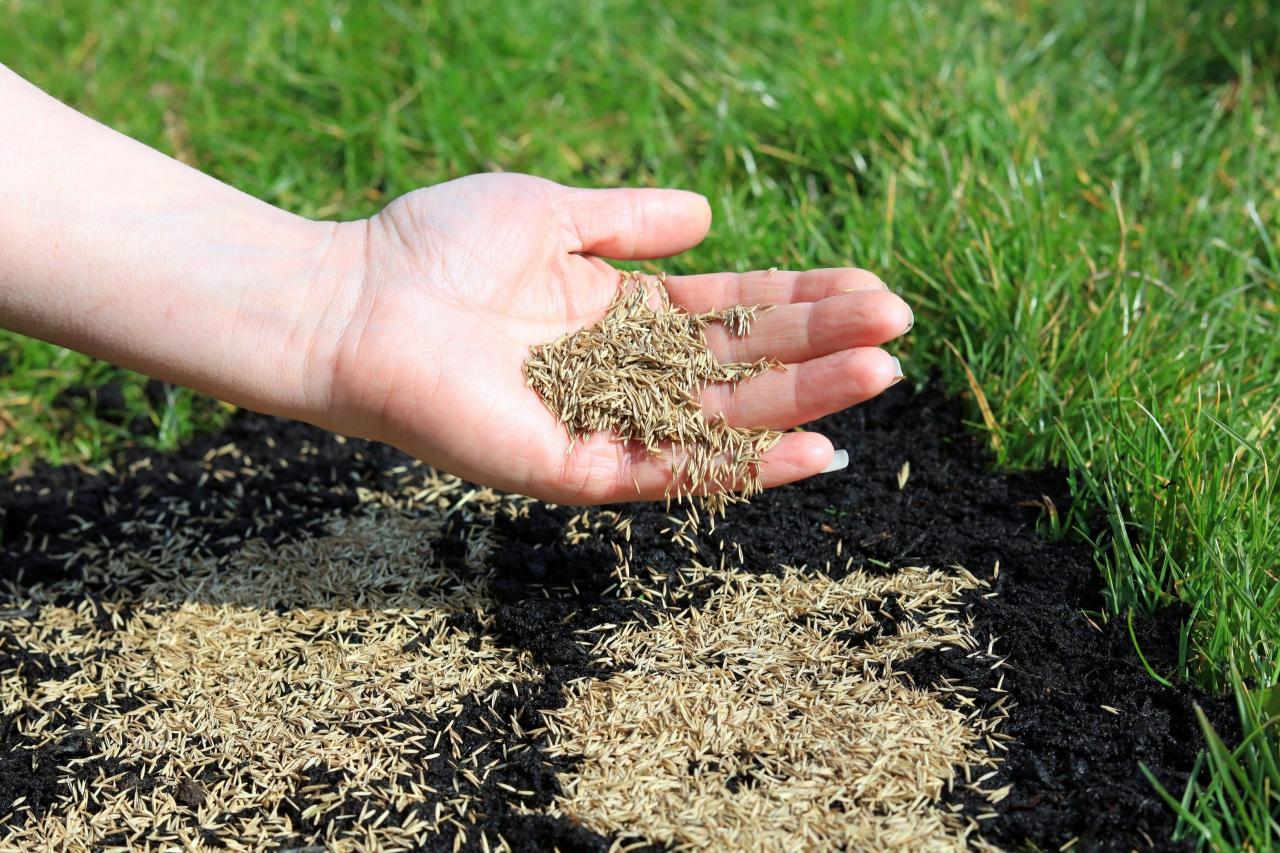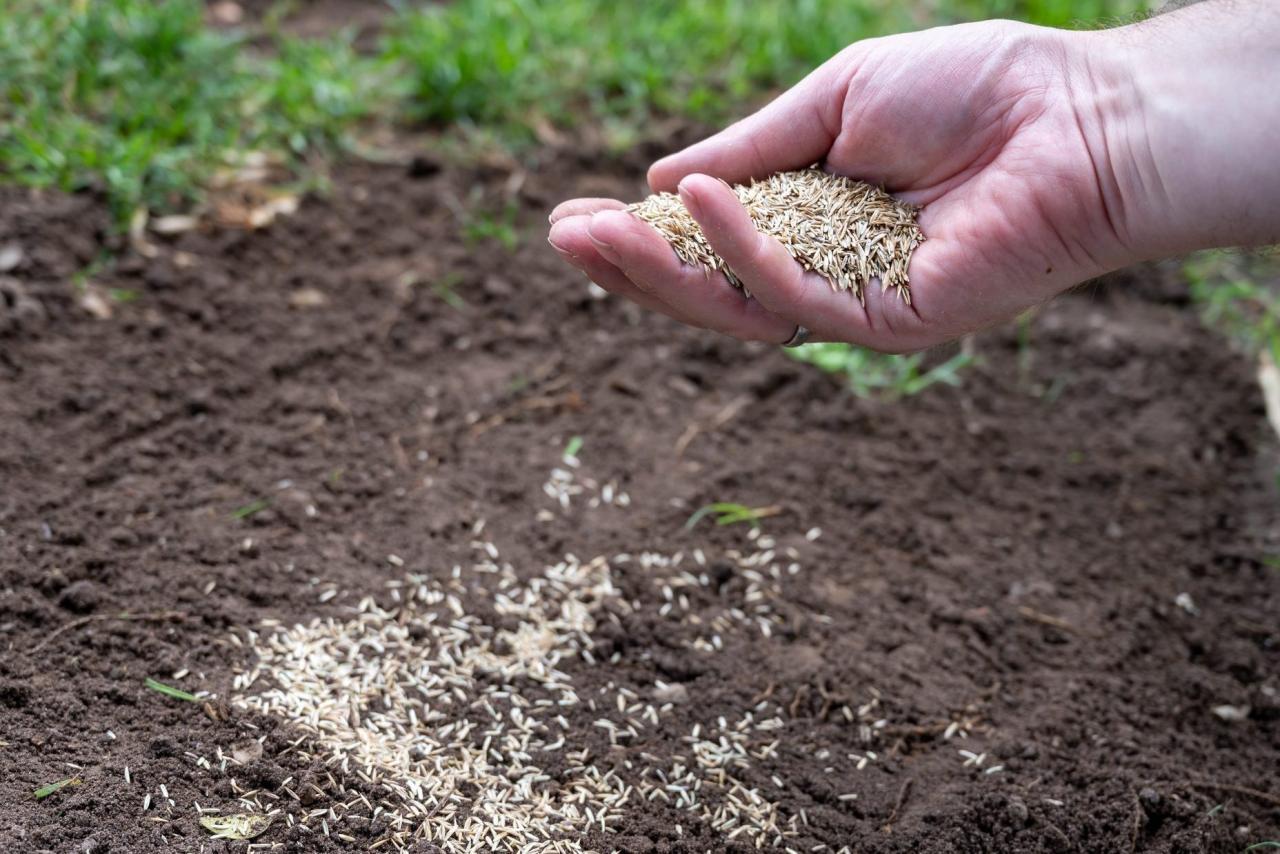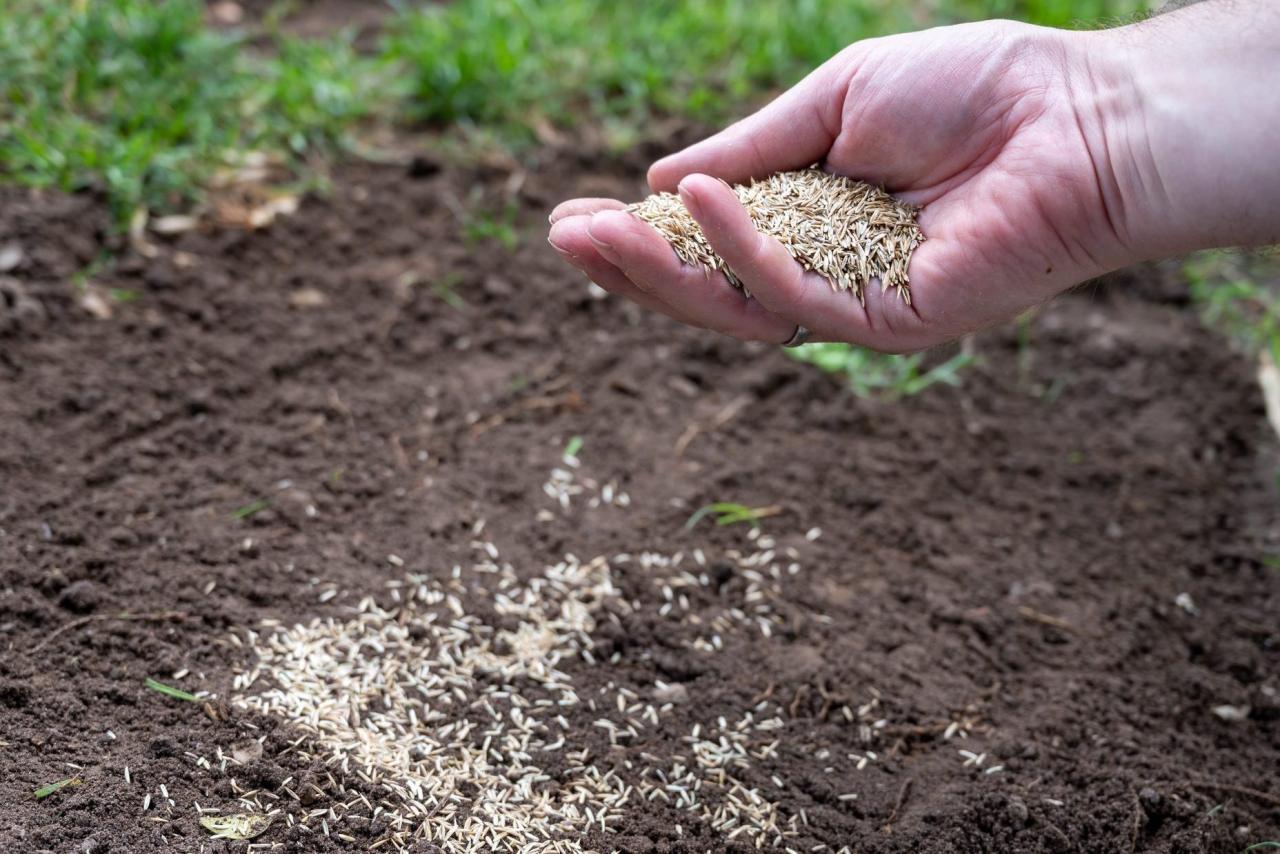Will Grass Seed Grow in September? Here’s What You Need to Know. September is a popular time for seeding, offering a chance to establish a lush lawn before the colder months arrive. However, success depends on a combination of factors, including proper timing, ideal conditions, and careful preparation.
Understanding the nuances of seeding in September can make all the difference in achieving a thriving lawn.
From selecting the right grass seed to ensuring proper post-seeding care, this guide provides a comprehensive overview of the essential steps involved in achieving a successful September seeding project. Whether you’re a seasoned gardener or a novice, this information will equip you with the knowledge to make informed decisions and achieve your lawn goals.
Will Grass Seed Grow in September? Here’s What You Need to Know
Timing is crucial for successful grass seed germination. While spring is often considered the ideal time for seeding, September can be a great alternative, especially in cooler climates. This is because September offers a balance of favorable conditions, including cooler temperatures, adequate moisture, and less competition from weeds.
September provides an ideal window for seeding because the soil temperature is typically cooler, which is essential for grass seed germination. This cooler temperature helps prevent the seeds from drying out too quickly, allowing them to establish a strong root system.
Additionally, the weather in September often features consistent rainfall, providing the necessary moisture for seed germination and growth.
Factors Influencing Success
While September offers favorable conditions, several factors can influence the success of grass seed germination. These include:
- Soil Type:Different soil types have varying drainage and water retention properties. Sandy soils tend to drain quickly, requiring more frequent watering, while clay soils can retain moisture for longer periods.
- Climate:The climate in your region will influence the optimal seeding time. In areas with mild winters, September seeding can be successful. However, in colder regions, early fall seeding might not allow the grass to establish sufficiently before winter.
- Sunlight:Grass seeds need adequate sunlight for germination and growth. Choose a location that receives at least six hours of direct sunlight per day.
- Competition:Existing weeds can compete with newly seeded grass for resources, hindering its growth. Before seeding, remove existing weeds to give the grass a better chance of establishing itself.
Ideal Conditions for Grass Seed Germination
Successfully establishing a lush lawn in September requires understanding the ideal conditions for grass seed germination. While September can be a suitable time to sow grass seed in many regions, ensuring the right environment is crucial for successful seed establishment.
Temperature
Temperature plays a crucial role in grass seed germination. The optimal temperature range for most cool-season grasses, such as Kentucky bluegrass, fescue, and ryegrass, is between 60°F and 75°F (15°C and 24°C). September often provides these ideal temperatures in many parts of the world.
However, it’s essential to monitor local weather patterns and adjust seeding practices accordingly.
Soil Moisture, Will Grass Seed Grow in September? Here’s What You Need to Know
Consistent soil moisture is critical for seed germination and root development. The soil should be consistently moist, but not waterlogged. Waterlogged soil can lead to root rot and hinder germination. Ideally, the soil should retain moisture for the first few weeks after seeding.
Regular watering, especially during dry periods, is essential for successful establishment.
Sunlight
Sunlight is essential for healthy grass growth. Most cool-season grasses require at least six hours of direct sunlight per day. Choose a sunny location for your lawn and ensure that the grass seed has ample access to sunlight.
Shaded areas may experience slower germination and weaker growth.
Preparing the Soil for Seeding
Preparing the soil is a crucial step in ensuring successful grass seed germination and a healthy lawn. A well-prepared seedbed provides optimal conditions for root development and nutrient absorption.
Tilling and Removing Weeds
Tilling the soil before seeding helps break up compacted soil, improve drainage, and create a suitable seedbed. This process also removes existing weeds and their root systems, preventing competition for nutrients and water. If you’re dealing with a heavy clay soil, consider adding organic matter, such as compost, to improve its structure and drainage.
Amending the Soil
Soil amendments are essential for adjusting the soil’s pH and providing essential nutrients for grass growth. A soil test can reveal nutrient deficiencies and pH imbalances, guiding you on the appropriate amendments.
Soil Test and Amendments
A soil test is a valuable tool for determining the specific needs of your soil. It analyzes the pH level and nutrient content, providing recommendations for adjustments.
Soil Type |
Recommended Soil Amendment |
Purpose of the Amendment |
Application Method |
|---|---|---|---|
Acidic Soil (pH below 6.0) |
Lime |
Increases soil pH |
Spread evenly over the soil surface and incorporate into the top few inches |
Alkaline Soil (pH above 7.0) |
Sulfur |
Decreases soil pH |
Spread evenly over the soil surface and incorporate into the top few inches |
Nutrient-Poor Soil |
Compost or Fertilizer |
Provides essential nutrients for grass growth |
Spread evenly over the soil surface and incorporate into the top few inches |
Selecting the Right Grass Seed
Choosing the right grass seed is crucial for a successful lawn, especially when planting in September. You want to select varieties that thrive in your climate and soil conditions. This ensures your lawn establishes quickly and withstands the changing seasons.
Popular Grass Seed Types for September Seeding
When choosing grass seed for September planting, consider the following popular types:
- Kentucky Bluegrass:This cool-season grass is known for its deep green color, excellent wear tolerance, and ability to form a dense, attractive lawn. Kentucky bluegrass thrives in cooler climates with moderate humidity. It requires full sun to partial shade and moderate watering.
- Perennial Ryegrass:A fast-growing cool-season grass, perennial ryegrass is ideal for overseeding existing lawns or establishing new lawns quickly. It tolerates moderate foot traffic and can handle some shade. Perennial ryegrass requires full sun to partial shade and moderate watering.
- Fine Fescue:This cool-season grass is drought-tolerant and low-maintenance, making it a good choice for areas with limited water resources. Fine fescue is also shade-tolerant and thrives in cooler climates. It requires full sun to partial shade and low watering.
- Tall Fescue:Another cool-season grass, tall fescue is known for its durability and disease resistance. It tolerates a wide range of soil conditions and requires less frequent mowing. Tall fescue prefers full sun to partial shade and moderate watering.
Grass Seed Characteristics and Benefits
To help you choose the best grass seed for your lawn, here is a table summarizing their characteristics:
Grass Type |
Sun Exposure Preference |
Water Needs |
Growth Rate |
|---|---|---|---|
Kentucky Bluegrass |
Full sun to partial shade |
Moderate |
Moderate |
Perennial Ryegrass |
Full sun to partial shade |
Moderate |
Fast |
Fine Fescue |
Full sun to partial shade |
Low |
Slow |
Tall Fescue |
Full sun to partial shade |
Moderate |
Moderate |
Seeding Techniques

Successfully establishing a new lawn or overseeding an existing one depends on using the right seeding techniques. These techniques ensure proper seed-to-soil contact, optimal germination, and even grass growth.
Recommended Seeding Depth
The depth at which you sow grass seed plays a crucial role in its germination and establishment. Too shallow, and the seeds may dry out; too deep, and they may not have enough energy to reach the surface. The recommended seeding depth varies depending on the grass type.
- Fine-leaved grasses(like Kentucky bluegrass, perennial ryegrass, and fescue) typically require a seeding depth of ¼ to ½ inch.
- Coarse-leaved grasses(like Bermuda grass and zoysia grass) can be sown a bit deeper, at ½ to ¾ inch.
Importance of Proper Seed Distribution
Even seed distribution is essential for achieving a uniform and dense lawn. Uneven seeding can lead to patchy areas with sparse grass growth. To ensure proper distribution, it’s crucial to use the right seeding technique and adjust the seed rate based on the grass type and the area you’re seeding.
While September is a great time to get your lawn ready for the fall, you might also consider adding a splash of color with some beautiful flowering plants. Columbine, with its delicate blooms and intricate foliage, makes a wonderful addition to any garden.
Learn more about this enchanting flower and its care in Unveiling the Beauty of Columbine Plants: A Gardener’s Guide , and then get back to your lawn care. After all, the key to a thriving lawn is proper seed selection and timely planting.
Seeding Techniques
Several techniques can be used for sowing grass seed, each with its advantages and disadvantages.
Broadcasting
Broadcasting involves scattering seed evenly over the prepared soil. This method is simple and quick but may not be the most accurate. It’s best suited for small areas or when overseeding an existing lawn.
Overseeding
Overseeding involves scattering seed over an existing lawn to thicken it or introduce new grass types. This technique is often used in the fall to rejuvenate a lawn.
Using a Seed Spreader
A seed spreader is a tool that helps distribute seed evenly over a larger area. These spreaders come in various types, from manual to motorized, and can be adjusted to spread different seed types and rates. Using a seed spreader ensures a consistent seed distribution, resulting in a more uniform lawn.
Post-Seeding Care

After sowing your grass seed, consistent and proper care is crucial for successful germination and establishment. This involves creating the ideal environment for your new lawn to thrive. Here’s what you need to know about post-seeding care to ensure a healthy and vibrant lawn.
Watering
Watering is essential for grass seed germination and the development of a strong root system. Newly seeded areas require frequent and deep watering to keep the soil consistently moist. Shallow watering can lead to uneven germination and shallow roots, making the grass more susceptible to drought and stress.
The frequency of watering will depend on factors such as weather, soil type, and the type of grass seed used. Generally, water deeply enough to soak the soil to a depth of 2-3 inches, but avoid overwatering, which can lead to fungal diseases.
Fertilizing
Applying a starter fertilizer to your newly seeded area provides essential nutrients that help the young grass grow strong and healthy. Starter fertilizers are formulated with high phosphorus content, which promotes root development, and nitrogen, which supports healthy foliage growth.
Applying a starter fertilizer according to the product instructions can give your new lawn the boost it needs to establish a strong root system and resist disease. Follow the recommended application rate and timing, and avoid over-fertilizing, which can damage the grass.
Protecting from Pests and Diseases
Newly seeded areas are vulnerable to pests and diseases. It’s important to take steps to protect your new lawn from these threats. Pests such as grubs and cutworms can damage the young grass, while diseases like brown patch and dollar spot can cause discoloration and decline.
While September can be a good time to seed your lawn, it’s important to consider the specific needs of your grass type. Just as you would optimize conditions for a thriving Rodgers plant, as outlined in How to Maximize Your Rodgers Plant’s Growth Potential , understanding the ideal soil temperature and moisture levels for your grass seed is crucial for successful germination and establishment.
Here are some tips to protect your new lawn from pests and diseases:
- Choose disease-resistant grass varieties.
- Avoid overwatering, which can create conditions favorable for fungal diseases.
- Use a fungicide as a preventative measure, especially if your area has a history of disease problems.
- Monitor your lawn regularly for signs of pests and diseases.
- Apply an insecticide if you notice pest activity.
Post-Seeding Care Tasks
Post-Seeding Care Task |
Timing |
Method |
Benefits |
|---|---|---|---|
Watering |
Immediately after seeding and daily for the first few weeks, then reduce frequency as the grass establishes. |
Use a sprinkler or hose to soak the soil to a depth of 2-3 inches. |
Provides consistent moisture for germination and root development, promotes healthy growth. |
Fertilizing |
Apply a starter fertilizer 2-3 weeks after seeding. |
Use a spreader to apply the fertilizer evenly over the seeded area. |
Provides essential nutrients for root development and healthy foliage growth. |
Protecting from Pests and Diseases |
Monitor the lawn regularly for signs of pests and diseases. |
Use preventative measures such as disease-resistant grass varieties, proper watering, and fungicide applications. |
Reduces the risk of damage and decline from pests and diseases, promotes a healthy and thriving lawn. |
Mowing |
Begin mowing once the grass has reached a height of 3-4 inches. |
Use a sharp mower and set the blade height to 2-3 inches. |
Encourages the grass to thicken and spread, promotes a healthy and uniform lawn. |
Common Challenges and Solutions
While September offers a favorable window for seeding, it’s not without its challenges. Factors like weed competition, pest infestations, and unpredictable weather can hinder successful germination and establishment. Understanding these challenges and implementing effective solutions is crucial for maximizing your chances of a healthy, thriving lawn.
Overcoming Common September Seeding Challenges
Challenge |
Cause |
Solution |
Benefits |
|---|---|---|---|
Weed Competition |
Existing weeds can outcompete newly sown grass seeds for resources like sunlight, water, and nutrients. |
|
|
Pest Infestations |
Insects like grubs, chinch bugs, and white grubs can damage newly sown grass seeds and seedlings. |
|
|
Extreme Weather Conditions |
September can bring unpredictable weather, including drought, heavy rainfall, and temperature fluctuations. |
|
|
Conclusion: Will Grass Seed Grow In September? Here’s What You Need To Know
Seeding in September can be a rewarding experience, offering the opportunity to establish a vibrant lawn that will thrive in the coming seasons. By understanding the key factors that influence success, preparing the soil adequately, selecting the right grass seed, and providing proper post-seeding care, you can increase your chances of achieving a healthy and beautiful lawn.
Remember, patience is key, and with consistent effort, you can enjoy the fruits of your labor for years to come.
Expert Answers
What are the best types of grass seed for September seeding?
The best grass seed types for September seeding vary depending on your climate and soil type. Cool-season grasses like Kentucky bluegrass, fine fescue, and perennial ryegrass are well-suited for cooler climates and can germinate in the fall. Consult a local nursery or lawn care professional for recommendations specific to your region.
Can I seed over existing grass in September?
Yes, you can overseed existing grass in September. This technique involves spreading new grass seed over your existing lawn to thicken it or introduce new varieties. It’s best to choose a grass seed blend that complements your existing lawn type.
How long does it take for grass seed to germinate in September?
Grass seed germination time in September can vary depending on factors like temperature, moisture, and seed type. Generally, cool-season grasses can take 10 to 21 days to germinate, but it may take longer in cooler temperatures.
What should I do if my new grass seed isn’t germinating?
If your grass seed isn’t germinating, consider the following: Ensure adequate moisture, check soil temperature, and ensure proper seed depth. If you’ve ruled out these factors, it may be necessary to reseed the area or consult a lawn care professional for further assistance.
